Xiaomi Mi Band 6 Review: surpassing its forerunner

In terms of functionality, Xiaomi Mi Band 6 is the most exciting device in the category. Super-bright and large screen, still impressive battery life (a week of maximal performance at ease) and new features (heart rate monitor, additional workout modes).
3 reasons to buy Xiaomi Mi Band 6:
- the screen is a bomb
- reference functionality in its category
- developed ecosystem (smart scales and smart sneakers can be connected via the application)
2 reasons not to buy the Xiaomi Mi Band 6:
- you are already stuck in another ecosystem (Samsung, Huawei / Honor, Fitbit, Apple)
- you have a Xiaomi Mi Band 5
Year by year, Xiaomi releases one hit after another in the world of smart bracelets, pushing the growth of the category and raising the benchmark in its segment. After Xiaomi Mi Band 5, the gg editorial team thought it couldn't get any better, faster, higher, and stronger. But the new Xiaomi Mi Band 6 has exceeded expectations.
How does Xiaomi Mi Band 6 differ from Xiaomi Mi Band 5?
Improved display. The new product has a 1.56-inch screen and a resolution of 360 × 152. The quality of the matrix is fire! AMOLED is at its best. A bonus - reduced frames around the display.

Pulse oximeter. Trend of the year, no comment.
More workouts. The novelty supports about 20 types of workouts, including such unexpected ones as stretching, bowling, street dancing, zumba, etc.
Xiaomi Mi Band 6 design
You can distinguish Mi Band 6 from its forerunner only by the quality of the display: now it is bigger, brighter, with smaller bezels. That is actually all. Neither weight nor other characteristics have changed. In other respects, Mi Band 6 is the most typical smart bracelet. By the way, the straps from the last generation also fit it.
Particularly I want to mention the super-compact charger. It is attached to the bracelet with a magnet. Despite the small size, the magnet is good enough and adheres well.
.jpg)
.jpg)
.jpg)



Xiaomi Mi Band 6 screen
.jpg)
Although Xiaomi and many other manufacturers use AMOLED screens in their smart bracelets, this never means that the screen will automatically be cool. AMOLEDs in low-cost devices can look dull and miserable. Here the screen is juicy and also has a high resolution (326 ppi pixel density).
A narrow vertical screen is not the most convenient solution for reading text, but this device provides the most that a smart watch can give. The font is readable, indentation, line spacing, and other characteristics that affect readability, too.
How notifications look on Mi Band 4, Mi Band 5 and the latest Xiaomi Mi Band 6
The display has a huge margin of brightness - up to 450 nits. I'm not complaining about the light sensor. There are no questions about the quality of the oleophobic coating either.
The model supports 130 types of dials. I really liked the one that is enabled by default. It is informative, comfortable, and looks neutral. But for those who are ready for visual experiments, the bracelet has something to surprise.


















The dial setup reminded me of the desktop setup on Windows. There's a large selection of pictures, and fine-tuning of font colors (not for all dials, but still). The menu includes an set of nature pictures, anime characters, and cyberpunk-themed fantasies, etc.
In fact, it is on the changing dials that the quality of the matrix is revealed. Photos are why we need these rich colors and high resolution. Thanks to such display characteristics, all the pictures on the Xiaomi Mi band 6 screen look cool, not shameful, as they could if the company would have suddenly decided to save money.
Functions
Sport
The Mi Band 6 menu now has about 20 types of workouts. Including stretching, basketball, HIIT, bowling, boxing, etc. But the most valuable thing about this device is that you can select a list of workouts to display and not get lost later in a long menu in search of the right one among kickboxing and zumba.






In general, this kind of customization is, for me, one of the key advantages of the Xiaomi platform. On wearable gadgets, the screen is too small to allow users to remove unnecessary things from it and not sink into unnecessary options. Other manufacturers should definitely follow suit.
I can't say much about the accuracy of workout measurements, because there is no way to compare it with medical devices. I can say for sure that the bracelet regularly counts fewer calories and steps than the Huawei/Honor device.
In addition to workouts and pedometer, Xiaomi smart bracelets have such an indicator as PAI, which is based on heart rate values, but it is basically monitoring physical activity in general. In my opinion, this is a useful feature that should also be adopted by other manufacturers, and it is an advantage in favor of choosing the Xiaomi device.






Sleep
Xiaomi smart bracelets still don't have a smart alarm clock. But let's be honest, do any of you use it? I don't, although my wearable device does.
The alarm clock has a bad feature - it doesn't vibrate for long. If you have trouble waking up to your alarm clock, the Mi Band 6 might have a little trouble waking you up. But you can delay the alarm for a long time (again, compared to Huawei/Honor, whose alarm can be delayed for half an hour).
The Mi Band 6 has fairly detailed sleep analytics and even recommendations on how to improve it. The watch also monitors sleep breathing, but this feature needs to be turned on separately in the menu.
All smartwatches don't like short deep sleep - and the Mi Band 6 is no exception. All give recommendations on how to improve it, all recommendations are the same and completely useless.
I can say about Mi Band 6 that its performance is similar to the Huawei/Honor device I use regularly. But not identical, which is often the case with different smart bracelets and indicates that their accuracy is far from medical.










Pulse Oximeter
This model has it, it takes about a minute to measure. Accuracy, of course, is not medical, which is simply impossible, as the wrist is not suitable for accurate measurement of blood oxygen saturation. The bracelet can give rough indications that doctors will not believe. But if you feel breathing problems and the bracelet shows a low level of blood oxygen saturation (consistently less than 95%), this is a reason to visit a doctor.
Interface and other features
It was already mentioned above that Xiaomi allows you to customize the interface of the bracelet by choosing which applications will be displayed on it. This is the first advantage.
The second is large icons that are easy to get into.

The interface is smooth and the finger glides so well on the screen with the oleophobic coating that it seems that the bracelet responds to the user's actions instantly.
I want to highlight as well a very sensible timer, in which you can set both minutes and seconds. Some of the competitors don't have that.
.jpg)
Similar to the previous generations, this one has music and smartphone camera control functions that are in demand by some users.
There is also a breathing workout and a stress measurement function. The benefits of both are not clear to me, to be honest, but surely if there is a supply, so is the demand.






















Ecosystem
The biggest catch in choosing a smartwatch or smart bracelet today is that you immediately have to subscribe to a certain ecosystem of devices (don't even think that if you follow a pedometer with passion, you won't be tempted by smart sneakers or smart scales sooner or later).
Eco-system is on the one hand a plus to choosing a certain brand. On the other hand - keep in mind that it will be expensive to switch to another brand, so immediately look at what the manufacturer offers.
Chinese brand Xiaomi is the king of the ecosystem. Smart sneakers and smart scales can join a smart bracelet in the Mi Fit app.






From the application you can find out that Xiomi smart scales, for example, know how to determine how well the user is with coordination, as well as the body composition (how much water, fat, muscles, etc.).
Battery life
Despite the increased diagonal and screen resolution, neither the battery capacity (125 mAh), nor the claimed battery life (up to 14 days) has changed compared to the previous generation. If the continuous heart rate monitoring is disabled in the bracelet and no notifications all day long, then we can really say that the lifespan is comparable to the declared one. If the measurements are turned on in full, and there are still workouts, notifications, an alarm clock, etc., then the bracelet loses 10-15% of its charge per day and you should expect about a week of work.
Summary
With the Mi Band 6 smart bracelet, Xiaomi has set a new benchmark for the market in terms of display quality. It's super enjoyable to use. I can safely recommend it for purchase to those whose budget is not yet ready for a smartwatch, but ready for a worthy smart bracelet.
Mi Band 6 fascinates at first sight, because the first look falls on the display, and it's great here. The pulse oximeter, lots of workout modes are essentially a tribute to fashion. Well, here it is.
Another benefit of the Mi Band 6 is Xiaomi's ecosystem, which welcomes health-conscious consumers with smart sneakers and a watch to top it off.
7 things to know about Xiaomi Mi Band 6
- This is the best fitness bracelet on the market
- A pulse oximeter added measures blood oxygen saturation
- Very large and easy-to-use AMOLED display
- 20 training modes and sleep monitoring
- Interaction with other devices in Xiaomi ecosystem
- Convenient magnetic charging
- NFC for contactless payment options

